As doom and gloom have continued to swirl around the U.S. economy, exacerbated yet again by partisan histrionics in Washington — now over the debt ceiling — most market indicators continue to trend defiantly well, especially for design and construction.
Even the runaway inflation that seemingly supplanted the pandemic last year as the economy's biggest nemesis had largely fizzled out as winter began. But few seemed to notice. Tweeted economist Paul Krugman on January 21: "One thing I've been noticing in my correspondence is how many people think inflation is still running wild. The big deceleration in the second half of 2022 hasn't broken through to public consciousness."
What is taking hold among economists who follow the AEC industry is the notion that 2023 may not turn out to be a down year, after all.
Indeed, the American Institute of Architects (AIA) published its semi-annual Consensus Construction Forecast on January 13, combining the annual outlooks of nine separate forecasting entities focused on this industry. All told, the consensus foresees a 5.8% increase this year in nonresidential projects, led by a 9.5% surge in hotel construction and a 15.1% leap in manufacturing work. Overall activity is expected to flatten in 2024, albeit delivering a repeat of this year's expected strong performance.
“The U.S. economy will continue to face serious challenges as we move through 2023, dampening the construction outlook,” said AIA Chief Economist Kermit Baker, Hon. AIA, PhD. “However healthy architect and contractor project backlogs should ease the negative impact of an economic slowdown.”
- To view each of the forecasts in more detail, click here.
“Last year was a great year for the construction sector. One of the key storylines for 2022 was the return of enthusiasm and optimism in prospects for nonresidential growth,” said Richard Branch, chief economist for Dodge Construction Network. “While some of that will likely erode in 2023 as economic growth wanes, increased demand for some building types like data centers, labs, and healthcare buildings will provide a solid floor for the construction sector.”
Of the group, Dodge's 2023 forecast is by far the rosiest, predicting a 13.7% rise this year in nonresidential construction put-in-place, led by expected large gains in industrial (32.3%), healthcare (21.2%) and hotel projects (20.5%).
Among the other forecasters, S&P Global (+8.2%), FMI Corp. (+7.9%), and Moody's Analytics (+7.7%) are the most bullish for nonresidential work this year. On the less sunny end of the scale, Associated Builders & Contractors (+1.5) and Piedmont Crescent Capital (-0.5%) convey the most pessimism for this year.
"While we still see a narrow path to a soft landing, we fear the rolling recessions currently underway in the technology sector, housing, and commercial real estate will ultimately spread to the financial sector and pull the broader economy into recession later this year," said economist Mark Vitner of Piedmont Crescent Capital on his blog in early January.
“While 2023 continues to be filled with promise, contractors may soon show more concern,” echoed ABC chief economist Anirban Basu. “Anecdotal evidence suggests that financing commercial real estate projects is more difficult, due in part to recession predictions. The general increase in the cost of capital has also jeopardized many projects, with certain contractors noticing an increase in postponements.”
Even so, the Producer Price Index ended the year falling, which was a welcome sight for owners and all project team members.
Specifically, construction input prices fell 2.7% in December compared to the previous month, according to the U.S. Bureau of Labor Statistics’ Producer Price Index data released today. Nonresidential construction input prices also declined 2.7% for the month.
Overall construction input prices are 7.9% higher than a year ago, while nonresidential construction input prices are 7.6% higher. Crude petroleum prices fell sharply in December, down 14.9%, while natural gas prices surged 45.3%.
“This Producer Price Index data represents another positive development on the inflation front,” said Basu. “However, this is both good and bad news. Recent consumer and producer price releases indicate that inflation is fading, though it remains well above the Federal Reserve’s 2% target. Should inflation continue to abate, the Federal Reserve may be able to stop increasing interest rates sooner than anticipated. Interest rate-sensitive segments like real estate and construction would be among the primary beneficiaries. Contractors are currently maintaining their longest backlog since 2019, according to ABC’s Construction Backlog Indicator."
Construction employment gains, wages climb
"It is difficult to separate real gains in construction activity from mere inflation in labor and material prices. However, one method for disentangling the two is to look at construction employment levels, since increases in employment would strongly suggest an increase in output," notes AIA economist Baker. "Over the past year, nonresidential construction employment increased almost 4%, suggesting that a significant share of the increased spending resulted in increased construction output."
Hiring has continued to surge, along with wages, indicating that worker shortages remain a growing concern.
On January 6, the U.S. Bureau of Labor Statistics (BLS) reported that construction firms had added 28,000 employees in December and continued to raise wages for hourly workers more than other sectors as the industry’s unemployment rate fell to a record low for the month, according to an analysis by the Associated General Contractors of America (AGC) of the new BLS data. AGC officials said the data align with their newly released survey, which found the majority of contractors are optimistic about demand for most construction types, despite reporting difficulty filling positions.
“There are more people working in construction today than ever before, and those figures are likely to continue to increase,” said Ken Simonson, the association’s chief economist. “But as optimistic as contractors are about 2023, they remain worried about their ability find enough workers amid record-low unemployment.”
Construction employment totaled a record 7,777,000, seasonally adjusted, in December, an increase of 231,000 or 3.1% from a year earlier. Nonresidential firms—comprising nonresidential building and specialty trade contractors along with heavy and civil engineering construction firms—added 17,900 employees in December. Residential building and specialty trade contractors together added 9,500 employees.
Pay levels in the construction industry continued to increase in December at a faster pace than in the overall private sector. Average hourly earnings for production and nonsupervisory workers in construction—mostly hourly craft workers—climbed by 6.1 percent, from $31.25 in December 2021 to $33.15 last month. That increase exceeded the 5.0 percent rise in average pay for all private sector production workers. Such workers in construction now earn an average of 18.1 percent more per hour than in the private sector as a whole.
The unemployment rate among jobseekers with construction experience declined from 5% in December 2021 to 4.4% last month, while the number of unemployed construction workers fell by 11%, from 497,000 in December 2021 to 443,000. Last month’s figures were the lowest ever for December.
Simonson noted that AGC's new 2023 Construction Hiring & Business Outlook survey, conducted with Sage, found 69% of the more than 1,000 responding construction firms expect to increase their headcount in 2023, compared to 11% that foresee a decrease. But 80% of firms report having a hard time filling positions, compared to only 8% that report no difficulty.
If and when a recession arrives...
AIA notes that whenever an economic recession does inevitably arrive, the impact on the U.S. design and contruction industry will naturally be delayed. Most projects already underway as the slowdown hits are likely to continue to completion, and recent contractor backlogs, as noted by ABC, are at record highs of nine months. So any industry pain felt this year should be deferred considerably. But designers will feel it first.
"Like construction companies, architecture firms are sitting on elevated backlogs of around seven months," explains AIA's Baker. "However, unlike construction companies, architecture firms have seen that backlogs can evaporate when business conditions weaken as clients may decide to delay or even cancel projects if they no longer make economic sense."
For now, though, the industry continues to exceed expectations.
On January 24, Dodge reported that it's total U.S. construction starts jumped 27% in December to a seasonally adjusted annual rate of $1.185 trillion, according to Dodge Construction Network.
During the month, nonresidential building starts increased 51%, nonbuilding starts increased 30%, and residential starts rose less than one percent.
Across 2022, total construction starts were 15% higher than in 2021. Nonresidential building starts rose 38% over the year, nonbuilding starts were up 19%, and residential starts were down 3%.
“December starts revealed where the current strength in the construction lies: manufacturing and infrastructure,” said Dodge economist Branch. “It is those segments that will provide insulation for the sector as the economy softens in 2023. Recession or not, higher interest rates will weigh on the economy and restrain construction starts in 2023. However, it’s encouraging to know that the new year is starting with a great deal of positive momentum.”
How long that momentum will last, however, is a guessing game.
But for now, and even for the foreseeable future, it would appear that the economy's post-pandemic recovery is far from over. And who knows? If and when the Federal Reserve Bank stops raising interest rates this spring, as expected, we may even see another building resurgence.
##########















